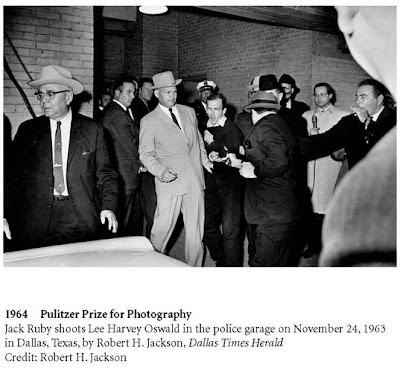 One of the most famous shots (literally and figuratively) in the history of American photojournalism was snapped by a photographer who’d already blown one chance to capture a historic moment, and was sure it was about to happen again. That’s just one of the fascinating stories behind the Pulitzer Prize winning photos on exhibit through January 24, 2010 at the Harry S.Truman Library and Museum.
One of the most famous shots (literally and figuratively) in the history of American photojournalism was snapped by a photographer who’d already blown one chance to capture a historic moment, and was sure it was about to happen again. That’s just one of the fascinating stories behind the Pulitzer Prize winning photos on exhibit through January 24, 2010 at the Harry S.Truman Library and Museum.
Next, Jackson made what he concedes was another big mistake. He left the motorcade and stayed at the famous grassy knoll, missing the chance to get a shot of the dying Kennedy being wheeled into the emergency room. “So, I thought, ‘I have really screwed up,'”Jackson said. Little did he know a chance to redeem himself–and to go down in history–would come two days later.
Because he worked the less than desirable Sunday shift, Jackson was assigned to shoot the perp walk of alleged assassin, Lee Harvey Oswald. It was expected to be so routine that Jackson actually had to fight to cover the story. His desk editor, annoyed that the event was already an hour and a half behind schedule, wanted to pull him off the shoot and send him on another assignment. Jackson recalls: “I said, ‘You must be kidding. There’s no way we’re going to leave here. You know, there’s just no way.'”
Jackson carefully positioned himself at the left rear fender of an unmarked police car, and focused on the location where he thought he could get the clearest shot of Oswald: “I was in the best spot. I thought, I want to be looking right at ’em when they came out of the crowd.'” He knew he’d only have one chance to get the shot, since the flash on his camera took up to 5 seconds to reset. He was in exactly the right place for the action to come towards him: “I’m ready, I’m waiting and they said here he comes,” recalled the photographer.
Then the unthinkable happened: “All of a sudden, I’m aware that somebody’s stepping out from my right really fast, you know two steps.” Thinking his shot was going to be blocked, Jackson snapped his picture. He estimates taking the photo 6/10’s of a second after Jack Ruby, the man he thought would ruin his photo, pulled the trigger of the pistol that killed Oswald: “I mean, I couldn’t have planned it any better. Talking about it, you know, it seems in slow motion, but it was really very quick.” Jackson’s careful planning, stubborn refusal to leave his assignment, and quick finger on the shutter, allowed him to shoot the now iconic photo that won him the Pulitzer Prize.
 Jackson’s Photo Of The Crowd Watching The President’s Motorcade At Main and Ervay Streets In Dallas, Taken About 3 minutes Before John F. Kennedy Was Shot.
Jackson’s Photo Of The Crowd Watching The President’s Motorcade At Main and Ervay Streets In Dallas, Taken About 3 minutes Before John F. Kennedy Was Shot. (Photo Courtesy Of Dallas Times Herald.)
Robert H. Jackson’s eyewitness accounts of two of the most controversial assassinations in American History have made him a favorite of conspiracy theorists. In recent interview Jackson recalled: “I stayed on the scene well after Oswald was taken away in the ambulance and I never did see any blood, not one drop. I sure did think it was strange not to see any blood whatsoever.” This statement was taken by some as evidence that Jack Ruby didn’t kill Lee Harvey Oswald on that Sunday in November, after all. But when asked directly about conspiracies, Jackson offered this opinion: “I saw Oswald acted alone. Nobody’s ever proved there was a conspiracy. Don’t you think after 46 years, somebody on their death bed would have spilled the beans if there was some sort of big plot because people can’t keep a secret that long? That’s just my feeling.”
The exhibit, Capture the Moment: The Pulitzer Prize Photographs, curated by the Washington D.C. based Newseum, has appeared in 17 cities, and is next bound for Korea. It will return to the U.S. in April 2011 at Omaha’s Durham Museum. The show can also be seen on permanent display at the Newseum, and the photos have been published as a hardcover book, The Pulitzer Prize Winning Photographs, available on the Newseum’s website.

